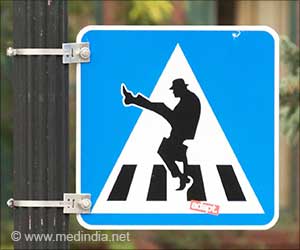The participants of the study included 13 healthy adults (six women, seven men) aged 22-71 years (average age 34) with no history of heart or lung disease, and no known gait disorder. Height and body weight were measured and each participant was shown a video of the Ministry of Silly Walks sketch before performing three walking trials, each lasting five minutes, around an indoor 30-meter course.
In the first trial, participants walked in their usual style at a freely chosen pace. For the next two trials, participants were asked to recreate, to the best of their ability, the walks of Mr. Teabag and Mr. Putey they had seen in the video.
Advertisement
The average speed was calculated using the distance covered during the five-minute walks. Oxygen uptake (mL/kg/min), energy expenditure (kcal/kg/min) and exercise intensity (METs), which is the number of calories expended per minute of physical activity were also measured.
Energy Expenditure in Teabag Style of Walking
The researchers found that only the Teabag walk resulted in a significantly greater energy expenditureabout 2.5 times that of usual walking. For men and women combined, oxygen uptake during normal walking was 11.3 mL/kg/min (or 3.2 METs), which was similar to that of the Putey walk (12.3 mL/kg/min, or 3.5 METs). However, the Teabag walk demonstrated an oxygen uptake of 27.9 mL/kg/min, or 8 METs, which qualifies as vigorous intensity exercise.
In terms of energy expenditure, exchanging just one minute of usual walking style with one minute of Teabag walking was associated with an increase in energy expenditure of 8 kcal/min for men and 5 kcal/min for women.
The researchers estimate that adults could achieve 75 minutes of vigorous intensity physical activity per week by walking in Teabag style- rather than their usual style- for about 11 min/day. And substituting usual style steps with Teabag style steps for about 12-19 min/day would increase daily energy expenditure by approximately 100 kcal.
Advantages of Teabag Style of Walking
This amount of walking in Teabag style would likely increase cardiorespiratory fitness, reduce mortality risk, and would require no extra time commitment because it replaces movement adults already do with higher energy physical activity, they add.
This is an experimental study based on a small sample, and the researchers acknowledge that some people, including those with disabilities, gait disorders, joint disease, or other health conditions might not be able to perform the Putey or Teabag walks. However, they might be able to otherwise increase energy expenditure in their daily movements, with inefficiency as the goal.
They also note that bursts of physical activity as short as one to two minutes, accumulated over time, can produce cardiovascular benefits, so people could engage in regular bursts of inefficient walking, at times and places that are most convenient for them, including indoors.
The analysis of the energy consumed during different styles of walking seeks to empower people to move their own bodies in more energetic and hopefully joyful ways.
Efforts to boost cardiovascular fitness should embrace inclusivity and inefficiency for all.
Reference :
- Quantifying the benefits of inefficient walking: Monty Python inspired laboratory based experimental study
– (https:www.bmj.com/content/379/bmj-2022-072833)
Source: Medindia



